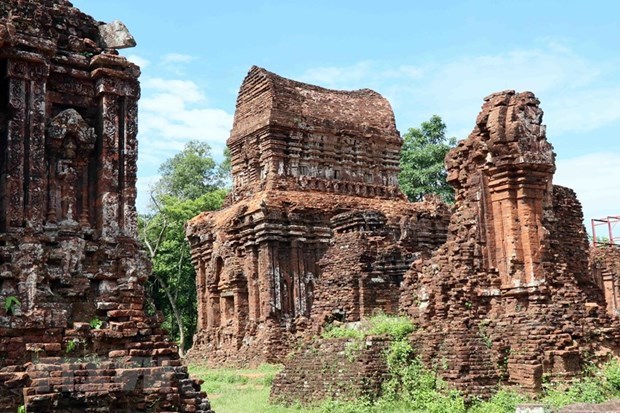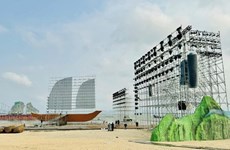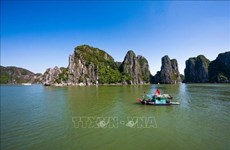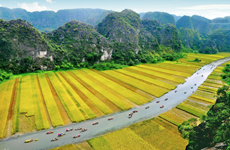Exploring My Son World Cultural Heritage
 Solemn beauty of ancient Champa towers in My Son world cultural heritage. (Photo: VNA)
Solemn beauty of ancient Champa towers in My Son world cultural heritage. (Photo: VNA)Going through ups and downs of history, My Son remains as a relic site with high cultural and artistic values, housing an architectural complex with numerous unique Champa towers and shrines.
The site, located in Duy Phu commune, Duy Xuyen district of the central province of Quang Nam, is the most renowned architectural complex of the Cham people in Vietnam.
It was built during the late 4th century and the 13th century.
In 1898, a French man discovered the My Son complex which hides itself in a narrow valley amidst forests. Not long after, scientists from the French School of the Far East arrived to study steels, architectural works and sculptures in My Son.
They were the ones who unveiled the secrets of My Son and introduced to the world the Cham culture and the temple complex as one of the world’s great religious constructions. The structure took more than a millennium to complete.
The construction of the relic began in the fourth century under the reign of King Bhadravarman, who ruled the kingdom from 349 to 361. It was completed in late eighth and early ninth century under the rule of King Jaya Simhavarman III.
My Son comprises more than 70 towers with various architectural and sculptural styles representing each historical period of the Champa Kingdom.
Most of the architectural works and sculptures at My Son were created under the influence of Hinduism.
A large number of towers face east where the sun rises and deities reside, while some others face west and both directions. They demonstrate a belief in the other world that kings will be honoured as deities as well as a way to express gratitude to their ancestors.
Destroyed during the war, in 1975, only 32 works remained in My Son, of them about 20 stayed intact. What was the most regrettable was the loss of the largest tower due to the US bombardment in 1969. It is a masterpiece of Champa architecture measuring 24m in height and having six satellite structures.
My Son towers are dedicated to Siva Bhadravarman, the first king of Amaravati region in the fourth century.
The relic was recognised by the United Nations Educational Scientific and Cultural Organisation (UNESCO) as a world cultural heritage site on December 1, 1999.
 A performance at an art programme held in My Son. (Photo: VNA)
A performance at an art programme held in My Son. (Photo: VNA)Most of the towers and auxiliary constructions were built with bricks using a refined technique. All patterns on stone pillars, round statues and sandstone reliefs are based on Hinduism.
The harmonious combination together with delicate carvings on exterior brick walls contribute to the beauty of My Son towers bearing the most outstanding traits of Champa art styles.
Serving as the centre of worship of the kingdom during nine centuries, the towers at My Son witnessed all ups and downs and changes of dynasties, as well as in people’s life.
The management board for My Son world cultural heritage site is coordinating with relevant parties in planting markers to delineate the boundary between the landscape conservation area and local residents' cultivation land to prevent encroachment and preserve the habitats of animals and plants in the conservation area.
Forests in this zone are rich in flora and fauna, and are currently home to 37 mammal species, including some listed in the Vietnam Red Data Book like Sunda slow loris, Sunda pangolin, wildcat, and small Indian civet.
They also harbour 238 plant species, including critically endangered ones such as “cho den” (Parashorea stellata), “gien trang” (Xylopia pierrei), “thanh nganh nam” (Cratoxylum cochinchinense), and “thanh nganh dep” (Cratoxylum formosum)./.













